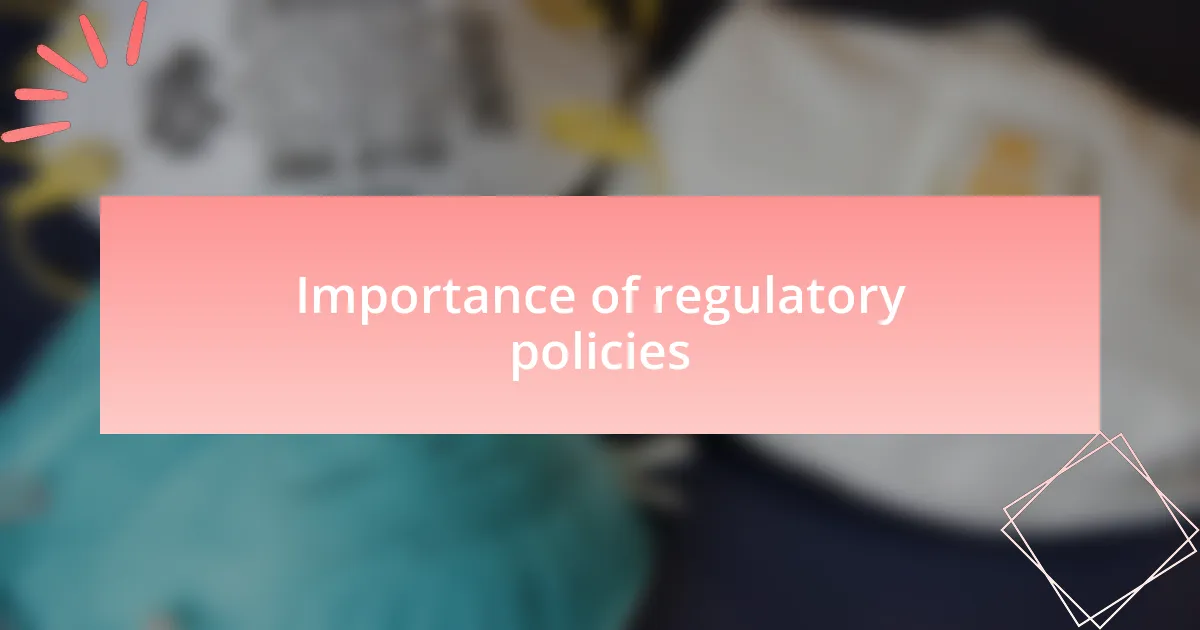Key takeaways:
- Healthcare innovation, including telehealth and AI, aims to improve patient outcomes and efficiency but raises questions about regulatory balance.
- Effective regulatory policies enhance patient safety, foster trust in the healthcare system, and encourage competition and innovation.
- Emerging regulatory frameworks must adapt to new technologies like telehealth and personalized medicine while ensuring safety and ethical standards.
- Challenges in adoption include fear of compliance issues, resource limitations for smaller organizations, and the potential stifling of innovation due to excessive regulations.

Understanding healthcare innovation trends
Healthcare innovation trends are often driven by a desire to improve patient outcomes and enhance the overall efficiency of the healthcare system. I remember when telehealth services started gaining traction; the excitement was palpable. Patients could finally receive care from the comfort of their homes, and I couldn’t help but think: isn’t that what we’ve been aiming for all along?
As I observe the rise of artificial intelligence in healthcare, it strikes me how this technology not only speeds up diagnosis but also offers personalized treatment plans. I once spoke with a physician who mentioned that AI systems saved him hours of paperwork, allowing him to spend more time with patients. Wouldn’t we all rather have healthcare professionals focused on caring for us, rather than drowning in administrative tasks?
Moreover, the integration of wearable technology is reshaping how we approach preventative care. I once attended a conference where a speaker showcased how real-time health data from wearables could alert us to potential health risks before they escalate. This prompts a pivotal question: how many of us are truly ready to embrace a proactive approach to our health, rather than waiting for problems to arise?

Importance of regulatory policies
When considering regulatory policies, I often reflect on their role in safeguarding patient safety. In my experience, I have seen how regulations can create a necessary framework that not only protects patients but also encourages innovation. For instance, think about the implications if new treatments or technologies were introduced without any oversight—would we trust them?
Moreover, regulatory policies can foster trust in the healthcare system. I recall a time when a new drug was launched, and the rigorous approval process was front and center in discussions. People seemed reassured knowing that extensive research and testing had been conducted to ensure safety and efficacy. Isn’t it comforting to know that there are checks and balances in place?
On a broader scale, effective regulatory frameworks encourage competition and drive innovation. I once attended a workshop where industry leaders discussed how clear regulations can create a level playing field, enabling new startups to compete with established companies. This competition can lead to breakthroughs, but without regulations, would there be the same motivation for companies to innovate?

Overview of emerging regulatory policies
Emerging regulatory policies are shaping the future of healthcare in ways we are just beginning to understand. For instance, I remember attending a recent symposium where experts discussed artificial intelligence in healthcare. The conversation became particularly animated around AI regulations, highlighting the need for guidelines that ensure ethical data use while still allowing for technological advancements. Isn’t it fascinating to think about how regulations can both empower innovation and protect patient rights simultaneously?
Another development I’ve observed recently is the increasing emphasis on telehealth regulations. Having utilized telehealth services myself, I can personally attest to the convenience it brings, especially for rural patients. However, with this growth come challenges regarding reimbursement policies and quality standards. These conversations are crucial as they impact how health systems adapt to technology. How can we ensure that regulations keep pace with these rapidly changing modalities while still prioritizing care quality?
Finally, the rise of personalized medicine is sparking discussions around regulatory frameworks that can accommodate unique treatments. The idea that a treatment can be tailored to an individual’s genetic makeup is revolutionary, but it also raises questions: How do we regulate something that doesn’t fit a one-size-fits-all model? As policies begin to evolve, it’s exciting—and a little daunting—to consider how they will navigate the complexities of innovation in personalized healthcare. The balance between fostering innovation and protecting patients will likely remain a central theme in the development of these policies.

Impact of policies on innovation
The interplay between regulatory policies and innovation is often a delicate dance. I recall an instance where a new policy aimed at streamlining approval processes for medical devices was introduced. Initially, it felt like a green light for innovation, and I was excited to see how it would foster creativity in device design. However, it quickly became clear that without careful oversight, this rush could lead to untested products entering the market, putting patients at risk. How do we find that sweet spot where policies encourage innovation without sacrificing safety?
When I reflect on the rapid adoption of telemedicine during recent years, I see both opportunities and hurdles created by new regulations. The flexibility offered by these policies has truly transformed patient access to care, yet the inconsistencies in how states approach telehealth can be frustrating. I wonder, are we creating unnecessary barriers that stifle the very innovations meant to enhance healthcare delivery? It’s a complex issue that demands our attention as we navigate the future of healthcare technology.
Personalized medicine serves as another striking example of the regulatory impact on innovation. The excitement among researchers and clinicians about tailored treatments is palpable, but I’ve observed how the lack of clear regulations can hinder progress. The conversations I’ve had with colleagues often circle back to the discomfort of innovating in a gray regulatory area. How can we push boundaries while ensuring patient’s rights and safety remain a top priority? The answers to these questions will undoubtedly shape the landscape of healthcare innovation in the years to come.

My perspective on current changes
As I observe the current shifts in healthcare regulations, I find myself reflecting on how these changes directly influence my day-to-day work. For instance, I recently engaged in discussions about the new data privacy policies surrounding patient information sharing. While I appreciate the intention behind these regulations, I couldn’t help but feel that they may unintentionally hinder collaboration among healthcare providers. Are we prioritizing data protection at the expense of real-time collaboration that could improve patient outcomes?
In another context, I’ve been closely following the evolving landscape of gene therapy regulations. It’s thrilling to see the progress being made, but I also feel a sense of apprehension. When I attended a recent symposium, the air was thick with excitement, yet I sensed a lingering concern among researchers about the pace of regulatory approvals. How can we strike a balance that allows us to innovate without compromising ethical standards? These dilemmas weigh heavily on my mind, reflecting the complexity of our journey in healthcare.
Finally, I can’t help but think about how the current changes might affect emerging technologies like artificial intelligence in diagnostics. I’ve seen firsthand how promising these tools can be in revolutionizing care delivery, yet the uncertainty surrounding regulatory frameworks leaves innovators in a tough spot. How do we harness AI’s potential while navigating the legal labyrinth? I believe it’s crucial for us to stay engaged in these discussions if we truly want to see healthcare flourish in innovative ways.

Challenges I foresee in adoption
Adoption of new regulatory policies is often met with skepticism, and I can see that firsthand. For example, when we introduced telehealth services at our clinic, we faced numerous hurdles in securing patient consent under the new data privacy regulations. It made me wonder—are these policies designed to protect patients, or do they create barriers that limit their access to vital care?
Another challenge I’m witnessing is the hesitancy of healthcare providers to embrace rapid innovations due to fear of compliance issues. I remember speaking with a colleague who was excited about implementing a new health tech solution, only to be deterred by concerns over meeting the regulatory requirements. This left me pondering: how can we encourage innovation when the fear of regulatory backlash casts such a long shadow?
The complexity of navigating these policies also raises questions about the resources required for compliance. I recently attended a meeting where it became clear that smaller healthcare organizations struggle to keep up due to limited budgets and expertise. This situation begs the question: are we inadvertently widening the gap between large and small providers? These challenges push us to rethink how we approach the adoption of regulatory changes in an ever-evolving healthcare landscape.